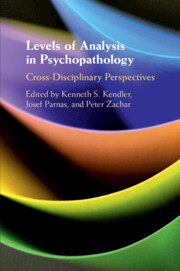Book contents
- Levels of Analysis in Psychopathology
- Advance Praise for Levels of Analysis in Psychopathology
- Levels of Analysis in Psychopathology
- Copyright page
- Contents
- Figures
- Tables
- Contributors
- Preface
- General Introduction
- Part I Neuroscience, Mechanisms, and RDoC
- Part II Phenomenology, Biological Psychology, and the Mind–Body Problem
- Part III Taxonomy, Integration, and Multiple Levels of Explanation
- Section 8
- Section 9
- Section 10
- Section 11
- Section 12
- Section 13
- 37 Introduction
- 38 The Impact of Faculty Psychology and Theories of Psychological Causation on the Origins of Modern Psychiatric Nosology
- 39 Commentary on “The Impact of Faculty Psychology and Theories of Psychological Causation on the Origins of Modern Psychiatric Nosology”
- Section 14
- Section 15
- Index
- References
38 - The Impact of Faculty Psychology and Theories of Psychological Causation on the Origins of Modern Psychiatric Nosology
from Section 13
Published online by Cambridge University Press: 02 April 2020
- Levels of Analysis in Psychopathology
- Advance Praise for Levels of Analysis in Psychopathology
- Levels of Analysis in Psychopathology
- Copyright page
- Contents
- Figures
- Tables
- Contributors
- Preface
- General Introduction
- Part I Neuroscience, Mechanisms, and RDoC
- Part II Phenomenology, Biological Psychology, and the Mind–Body Problem
- Part III Taxonomy, Integration, and Multiple Levels of Explanation
- Section 8
- Section 9
- Section 10
- Section 11
- Section 12
- Section 13
- 37 Introduction
- 38 The Impact of Faculty Psychology and Theories of Psychological Causation on the Origins of Modern Psychiatric Nosology
- 39 Commentary on “The Impact of Faculty Psychology and Theories of Psychological Causation on the Origins of Modern Psychiatric Nosology”
- Section 14
- Section 15
- Index
- References
Summary
During the development of psychiatric nosology during the nineteenth century, faculty psychological systems, often proposed by philosophers, played a substantial role in the development of psychiatric diagnostic systems. The most important of those faculties proposed were cognition and emotion. Because patients often displayed dysfunction in multiple faculties, alienists had to understand how these faculties interrelated. To address this question, nineteenth-century psychiatric diagnosticians postulated causal relationships based on folk criteria of understandability (although longitudinal observations were also utilized). This history puts efforts to apply hard reductionist models to the resulting psychiatric diagnostic categories in a conundrum. The naïve inductivist view of the origins of our psychiatric diagnostic categories – that they arose from raw observations by great skilled clinicians of the past – is untenable. Rather, the road from clinical observations to diagnostic categories passed through both theories of mental functioning (aka faculties) and hypotheses of mental causation between different disordered faculties.
- Type
- Chapter
- Information
- Levels of Analysis in PsychopathologyCross-Disciplinary Perspectives, pp. 462 - 478Publisher: Cambridge University PressPrint publication year: 2020
References
- 4
- Cited by



